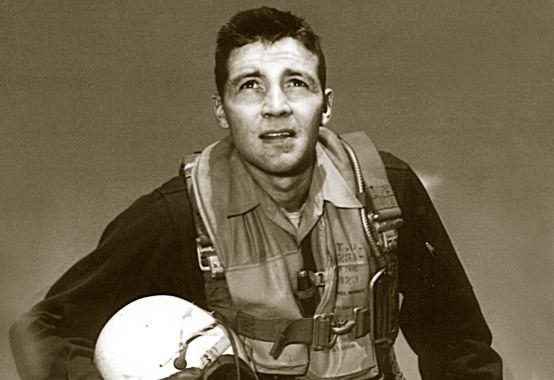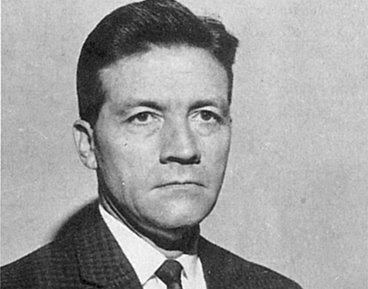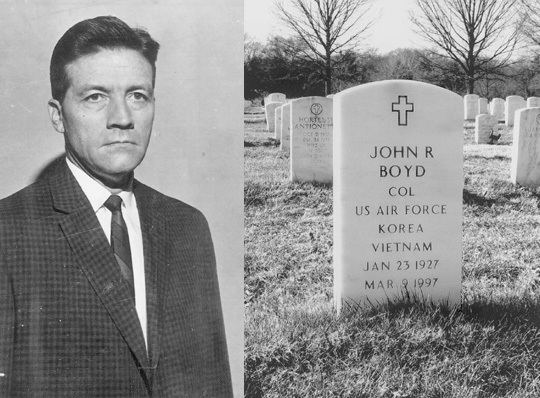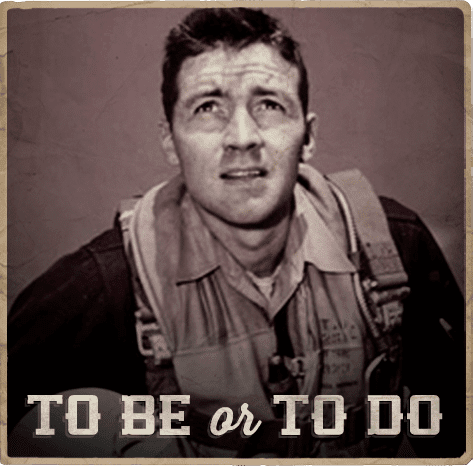Role Pilot Name John Boyd | ||
 | ||
Born January 23, 1927Erie, Pennsylvania ( 1927-01-23 ) Allegiance United States of America Years of service 1945–1948 (Army Air Corps)1951–1975 Education Georgia Institute of Technology People also search for Arthur W. Radford, Edward A. Craig, Joseph Stalin | ||
John boyd military strategist
John Richard Boyd (January 23, 1927 – March 9, 1997) was a United States Air Force fighter pilot and Pentagon consultant of the late 20th century, whose theories have been highly influential in the military, sports, business, and litigation.
Contents
- John boyd military strategist
- Col john boyd 1927 1997
- Early years
- Military career
- Military theories
- The OODA Loop
- Aerial Attack Study
- Foundation of theories
- Elements of warfare
- Military reform
- Maneuver warfare and the Marines
- References

Boyd inspired the Lightweight Fighter program (LWF) that produced the successful General Dynamics F-16 Fighting Falcon and McDonnell Douglas F/A-18 Hornet, which are still in use by the United States and several other military powers into the 21st century.

Col john boyd 1927 1997
Early years

Boyd was born on January 23, 1927 in Erie, Pennsylvania. He graduated from the University of Iowa with a Bachelor's degree in economics and later earned an additional bachelor's degree in industrial engineering from Georgia Tech. Boyd enlisted in the Army Air Corps on October 30, 1944; he was a junior in high school. On March 27, 1953 Boyd arrived in Korea as an F-86 pilot. Although Boyd was never credited with any kills, after his service in Korea he was invited to attend the most prestigious school a fighter pilot could attend, the Fighter Weapons School (FWS). Boyd attended the school and not only performed well, but rose to the top of his class. Upon graduation he was invited to stay at the FWS as an instructor. In Boyd’s time, being an instructor for the FWS was the most prized position any fighter pilot could hold. It was here that Boyd would revolutionize aerial tactics. His practice and teaching while at the FWS would sow early seeds for the later development of his concept of the OODA (observe, orient, decide, and act) loop.
Military career

As a high school graduate, Boyd enlisted in the United States Army and served in the Army Air Forces from 1945 to 1947, assigned as a swimming instructor in occupied Japan. After graduating from the University of Iowa, he served as a U.S. Air Force officer from July 8, 1951, until his retirement on August 31, 1975. Boyd flew a short tour (22 missions instead of 100) in F-86 Sabres during the Korean War, during which he served as a wingman and never fired his guns or claimed an aerial kill. Boyd was later assigned to the USAF Weapons School, where he became head of the Academic Section and wrote the tactics manual for the school. Boyd was also brought to the Pentagon by Major General Arthur C. Agan, Jr. to do mathematical analysis that would support the McDonnell Douglas F-15 Eagle program in order to pass the Office of the Secretary of Defense's Systems Analysis process.

He was dubbed "Forty Second Boyd" for his standing bet as an instructor pilot that beginning from a position of disadvantage, he could defeat any opposing pilot in air combat maneuvering in less than 40 seconds. According to his biographer, Robert Coram, Boyd was also known at different points of his career as "The Mad Major" for the intensity of his passions, as "Genghis John" for his confrontational style of interpersonal discussion, and as the "Ghetto Colonel" for his spartan lifestyle.

On his retirement in 1975 he was awarded the prestigious Harold Brown Award by the US Air Force.
Boyd died of cancer in Florida on March 9, 1997 at age 70. He was buried with full military honors at Arlington National Cemetery on March 20, 1997.
Military theories
During the early 1960s, Boyd, together with Thomas Christie, a civilian mathematician, created the Energy-Maneuverability theory, or E-M theory of aerial combat. A legendary maverick by reputation, Boyd was said to have stolen the computer time to do the millions of calculations necessary to prove the theory, though a later audit found that all computer time at the facility was properly billed to recognized projects and that no irregularity could be prosecuted. E-M theory became the world standard for the design of fighter aircraft. At a time when the Air Force's FX project (subsequently the F-15) was foundering, Boyd's deployment orders to Vietnam were canceled and he was brought to the Pentagon to re-do the trade-off studies according to E-M. His work helped save the project from being a costly dud, even though its final product was larger and heavier than he desired. However, cancellation of that tour in Vietnam meant that Boyd would be one of the most important air-to-air combat strategists with no combat kills. He had only flown a few missions in the last months of the Korean War (1950–1953), and all of them as a wingman.
With Colonel Everest Riccioni and Pierre Sprey, Boyd formed a small advocacy group within Headquarters USAF that dubbed itself the "Fighter Mafia". Riccioni was an Air Force fighter pilot assigned to a staff position in Research and Development, while Sprey was a civilian statistician working in systems analysis. While assigned to working on the beginnings of the F-15, called the Blue Bird at the time, Boyd disagreed with the direction the program was going and proposed an alternative "Red Bird". This concept was for a clear weather, air-to-air only fighter with a top speed of Mach 1.6 and max 5 1/2G turn, seeing the Blue Birds Mach 2.5 and 9G as unnecessary and inefficient, they also wanted the aircraft to be devoid of radar. Boyd and Sprey both proposed this concept to Air Staff but there were no changes to the Blue Bird.
Boyd was invited to Top Gun to brief the instructors on his "Energy Maneuverability" charts. Boyd's briefing did not go well. When Boyd insisted that it was impossible for the F-4 to win a dogfight against a MiG-17, the Top Gun instructors disagreed, two of them having shot down MiG-17s in combat. Commander Ron Mugs McKeown later said "Never trust anyone who would rather kick your ass with a slide rule than with a jet."
The Secretary of Defense, attracted by the idea of a low cost fighter, gave funding to Riccioni for a study project on the Lightweight Fighter program (LWF, which became the F-16). The DoD and Air Force both went ahead with the program, stipulating that it have a "design to cost" basis no more than 3 million per copy over 300 aircraft. The USAF considered the idea of a "Hi-lo" mix force structure and expanded the LWF program. The program soon went against the "Fighter Mafia's" idea: it was not to be the short ranged, low-tech, air-to-air aircraft they envisioned, but a medium-ranged, high-tech multi-role fighter-bomber.
After his retirement from the Air Force in 1975, Boyd continued to work at the Pentagon as a consultant in the Tactical Air office of the Office of the Assistant Secretary of Defense for Program Analysis and Evaluation.
Boyd is credited for largely developing the strategy for the invasion of Iraq in the Gulf War of 1991. In 1981, Boyd had presented his briefing, Patterns of Conflict, to Dick Cheney, then a member of the United States House of Representatives. By 1990, Boyd had moved to Florida because of declining health, but Cheney (then the Secretary of Defense in the George H. W. Bush administration) called him back to work on the plans for Operation Desert Storm. Boyd had substantial influence on the ultimate "left hook" design of the plan.
In a letter to the editor of Inside the Pentagon, former Commandant of the Marine Corps General Charles C. Krulak is quoted as saying "The Iraqi army collapsed morally and intellectually under the onslaught of American and Coalition forces. John Boyd was an architect of that victory as surely as if he'd commanded a fighter wing or a maneuver division in the desert."
The OODA Loop
Boyd's key concept was that of the decision cycle or OODA loop, the process by which an entity (either an individual or an organization) reacts to an event. According to this idea, the key to victory is to be able to create situations wherein one can make appropriate decisions more quickly than one's opponent. The construct was originally a theory of achieving success in air-to-air combat, developed out of Boyd's Energy-Maneuverability theory and his observations on air combat between MiG-15s and North American F-86 Sabres in Korea. Harry Hillaker (chief designer of the F-16) said of the OODA theory, "Time is the dominant parameter. The pilot who goes through the OODA cycle in the shortest time prevails because his opponent is caught responding to situations that have already changed."
Boyd hypothesized that all intelligent organisms and organizations undergo a continuous cycle of interaction with their environment. Boyd breaks this cycle down to four interrelated and overlapping processes through which one cycles continuously:
Of course, while this is taking place, the situation may be changing. It is sometimes necessary to cancel a planned action in order to meet the changes. This decision cycle is thus known as the OODA loop. Boyd emphasized that this decision cycle is the central mechanism enabling adaptation (apart from natural selection) and is therefore critical to survival.
Boyd theorized that large organizations such as corporations, governments, or militaries possessed a hierarchy of OODA loops at tactical, grand-tactical (operational art), and strategic levels. In addition, he stated that most effective organizations have a highly decentralized chain of command that utilizes objective-driven orders, or directive control, rather than method-driven orders in order to harness the mental capacity and creative abilities of individual commanders at each level. In 2003, this power to the edge concept took the form of a DOD publication "Power to the Edge: Command ... Control ... in the Information Age" by Dr. David S. Alberts and Richard E. Hayes. Boyd argued that such a structure creates a flexible "organic whole" that is quicker to adapt to rapidly changing situations. He noted, however, that any such highly decentralized organization would necessitate a high degree of mutual trust and a common outlook that came from prior shared experiences. Headquarters needs to know that the troops are perfectly capable of forming a good plan for taking a specific objective, and the troops need to know that Headquarters does not direct them to achieve certain objectives without good reason.
In 2007, strategy writer Robert Greene discussed the loop in a post called "OODA and You". He insisted that it was "deeply relevant to any kind of competitive environment: business, politics, sports, even the struggle of organisms to survive", and claimed to have been initially "struck by its brilliance".
The OODA Loop has since been used as the core for a theory of litigation strategy that unifies the use of cognitive science and game theory to shape the actions of witnesses and opposing counsel.
Aerial Attack Study
Boyd also served to revolutionize air-to-air combat in that he was the author of the Aerial Attack Study. The Aerial Attack Study became the official tactics manual for fighter aircraft. Boyd changed the way pilots thought; prior to his tactics manual, pilots thought that air-to-air combat was far too complex to ever be fully understood. With the release of Boyd’s Aerial Attack Study, pilots realized that the high-stakes death dance of aerial combat was solved. Boyd said that a pilot going into aerial combat must know two things: the position of the enemy and the velocity of the enemy. Given the velocity of an enemy, a pilot is able to decide what the enemy is capable of doing. When a pilot knows what maneuvers the enemy can perform, he can then decide how to counter any of the other pilot’s actions. The Aerial Attack Study contained everything a fighter pilot needed to know.
The overwhelming belief in the Air Force was that air-to-air combat was a thing of the past. Boyd proved that it was very much alive. The Air Force was moving away from aerial combat because of development in missiles. Boyd proved in his Aerial Attack Study that the art of the dogfight was not dead by showing that fighter pilots could out-maneuver missiles. John Boyd’s Aerial Attack Study was revolutionary because it was the first instance in history in which tactics were reduced to an objective state. Boyd’s manual proved that he was the undisputed master in the area of aerial combat. Within a decade the Aerial Attack Study became the text for air forces around the world.
Foundation of theories
Boyd never wrote a book on military strategy. The central works encompassing his theories on warfare consist of a several hundred slide presentation entitled Discourse on Winning & Losing and a short essay entitled "Destruction & Creation" (1976).
In Destruction & Creation, Boyd attempts to provide a philosophical foundation for his theories on warfare. In it he integrates Gödel's Incompleteness Theorem, Heisenberg's Uncertainty principle, and the Second Law of Thermodynamics to provide a context and rationale for the development of the OODA Loop.
Boyd inferred the following from each of these theories:
From this set of considerations, Boyd concluded that to maintain an accurate or effective grasp of reality one must undergo a continuous cycle of interaction with the environment geared to assessing its constant changes. Boyd, though he was hardly the first to do so, then expanded Darwin's theory of evolution, suggesting that natural selection applies not only in biological but also in social contexts (such as the survival of nations during war or businesses in free market competition). Integrating these two concepts, he stated that the decision cycle was the central mechanism of adaptation (in a social context) and that increasing one's own rate and accuracy of assessment vis-a-vis one's counterpart's rate and accuracy of assessment provides a substantial advantage in war or other forms of competition. The key to survival and autonomy is the ability to adapt to change, not perfect adaptation to existing circumstances. Indeed, Boyd noted that radical uncertainty is a necessary precondition of physical and mental vitality: all new opportunities and ideas spring from some mismatch between reality and ideas about it, as examples from the history of science, engineering and business illustrate.
Elements of warfare
Boyd divided warfare into three distinct elements:
Military reform
John Boyd's briefing Patterns of Conflict provided the theoretical foundation for the "defense reform movement" (DRM) in the 1970s and 1980s. Other prominent members of this movement included Pierre Sprey, Franklin C. Spinney, William Lind, Assistant Secretary of Defense for Operational Testing and Evaluation Thomas Christie, Congressman Newt Gingrich, and Senator Gary Hart. The Military Reform movement fought against what they believed were unnecessarily complex and expensive weapons systems, an officer corps focused on the careerist standard, and over-reliance on attrition warfare. Another reformer, James G. Burton, disputed the Army test of the safety of the Bradley fighting vehicle. James Fallows contributed to the debate with an article in The Atlantic Monthly titled "Muscle-Bound Superpower", and a book, National Defense. Today, younger reformers continue to use Boyd's work as a foundation for evolving theories on strategy, management and leadership.
Boyd gave testimony to Congress about the status of military reform after Operation Desert Storm.
Maneuver warfare and the Marines
In January 1980 Boyd gave his briefing Patterns of Conflict at the U.S. Marines AWS (Amphibious Warfare School). This led to the instructor at the time, Michael Wyly, and Boyd changing the curriculum, with the blessing of General Trainor. Trainor later asked Wyly to write a new tactics manual for the Marines. John Schmitt, guided by General Alfred M. Gray, Jr. wrote Warfighting, during the writing, he collaborated with John Boyd. Wyly, Lind, and a few other junior officers are credited with developing concepts for what would become the Marine model of maneuver warfare.
Wyly, along with Pierre Sprey, Raymond J. "Ray" Leopold, Franklin "Chuck" Spinney, Jim Burton, and Tom Christie were described by writer Coram as Boyd's Acolytes, a group who, in various ways and forms, promoted and disseminated Boyd's ideas throughout the modern military and defense establishment.
